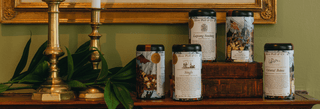Blog
-
History of teabags
The evolution of modern day tea bags is really steeped in history.
-
Lady Loutrel's Afternoon Tea as featured in Harper's Bazaar
Dear Friends, Recently, we posted about High Teas and that the Hotel Loutrel in downtown Charleston was featuring Oliver's Teas for their afternoon tea. I had the chance to...
-
Rooibos Tea
Dear Oliver, Rooibos has become my new best friend. I know, you could argue that I love all your products, Oliver, but right now rooibos has taken...
-
Enjoying High Tea
Starting in the month of May, The Hotel Loutrel in Charleston is beginning to offer high tea (Thursdays through Sunday) and will be serving Oliver Pluff Teas. You can...
-
Cacao Teas
As for consumption, cacao is said to be more bitter than its counterpart cocoa, which is often mixed with sugar. Therefore, different techniques have been developed to enjoy its complex...
-
'Tis the season for Tea Parties
Dear Oliver, December is an important month in the history of tea in the “New World” as earlyEuropeans dubbed the lands across the Atlantic. These early settlers were relianton European...
-
Happy Veteran's Day
As the United States prepares to honor its Veterans this November 11, it is interesting to note the role of tea and coffee as traditional staples for troops both stateside...
-
Tea in the 18th Century
At first, tea was mainly accessed and consumed by wealthy individuals and families. The high cost and the expensive tea “equipment” made purchasing prohibitive for most people. By the middle...
-
Labor Day Cold Teas
A cool morning at the beginning of September is what we call 'false-fall', and people in the south know 'second-summer' with the heat and humidity is coming back soon. ...
-
Tea Cocktails
Gunpowder Punch Any green tea will do, but we love the refreshing taste of Gunpowder garnished with fresh mint and a squirt of lemon. Ingredients: Gunpowder Tea Ginger Beer Rum...
-
Environmentally Friendly Teabags
The study, lead by Dr Nathalie Tufenkji, tested four kinds of plastic tea bags in boiling water, and found that a single bag would release more than 11 billion microplastic...
-
Colonial Tea Prices
The price of tea in England declined during the 18th century. Now able to afford this commodity, English laborers included tea in their budgets for the first time. A study...

